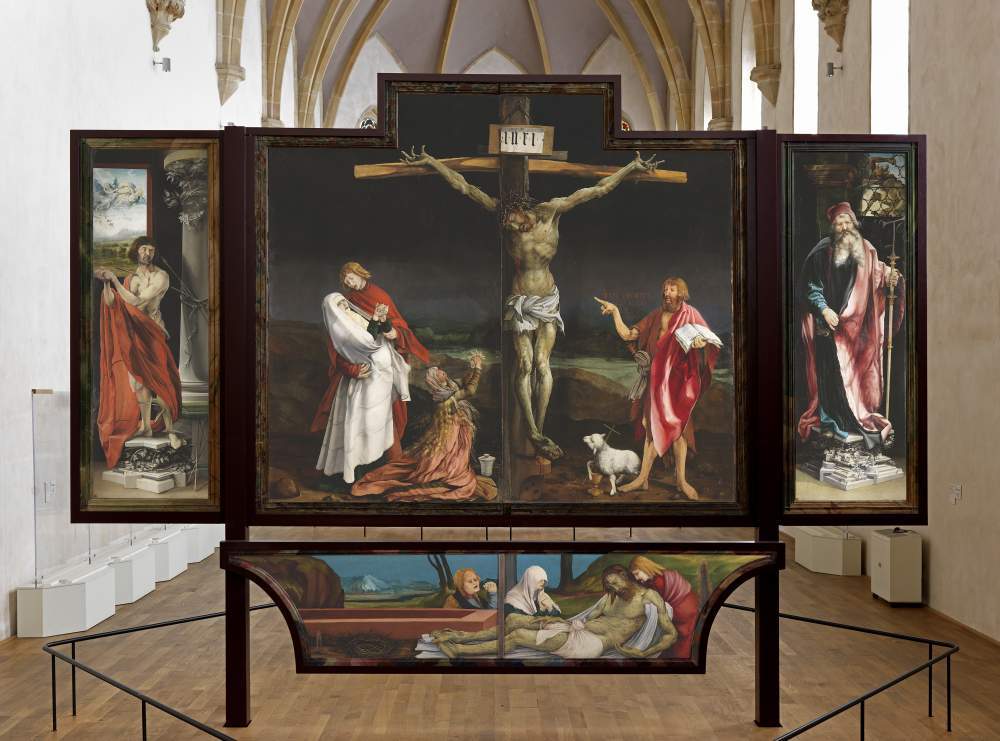France, restoration of Isenheim altar, Grünewald's masterpiece, completed.
In Colmar, France, the restoration of theIsenheim Altar, the monumental polyptych created between 1512 and 1516 by painter Matthias Grünewald (Würzburg, c. 1480 - Halle, 1528) and sculptor Niklas of Haguenau (Niklas Zimmerlin; Hagenau, 1445/1460 - 1538), a masterpiece in the collection of the Musée Unterlinden in Colmar. The work underwent an exceptional comprehensive restoration starting in 2018 (covering everything from painted panels and sculpture to frames and more), with visitors able to observe the completion of the process over the summer.
Following the 2003 report on the state of the painted panels and the conference edicate to Grünewald’s technique in 2006, it was observed that the Isenheim Altar was suffering from a heavy accumulation of dirt, while the painted panels had become noticeably darker and duller due to the many layers of oxidized varnish, threatening the coherence of the artwork as a whole. As part of a master plan to restore the works of the Musée Unterlinden, linked to its expansion and restoration, the regional restoration commission approved the start of restoration of the painted panels of the altarpiece in 2011. In 2013, the museum commissioned a new study in order to draw up specifications for a complete restoration of the altar’s various components: the painted panels and their frames, the sculptures, and the caisson, the wooden structure containing them, which dates back to 1930.
Under the auspices of the scientific committee composed of museum professionals, restorers, and art historians from France, Germany, and Switzerland, two teams were selected at the end of 2017, and in fall 2018 the extensive restoration program began at three sites. The team of painting restorers led by Anthony Pontabry worked on the restoration of the original painted panels and frames inside the chapel of the Musée Unterlinden, which was directly observed by the public. Restoring the altar to public view was a decision made out of a desire for transparency, and also not to disappoint the museum visitors who had come to admire the work.
Only the detachable frames of some of the panels (St. Sebastian, St. Anthony and the predella) were restored in Vesoul, at the Regional Laboratory for the Restoration and Conservation of Works of Art. The sculptures, which needed a specific space for the work to be undertaken, were restored in the polychrome wood restoration laboratory run by the Center for Research and Restoration of the Musées de France (C2RMF) in Paris, by the sculpture restoration team led by Juliette Lévy .
At the end of June 2022, after more than four years of restoration, in addition to the conservation measures and the brilliance of the newly discovered work, the public was able to admire for the first time the original consistency between the painted panels and the sculptures, particularly in terms of color. Comparative analysis of the pigments used for the sculptures and panels showed that Grünewald’s workshop actually applied color to the sculptures created by Niklas of Haguenau. The restored painted panels reveal the color range of the artist’s palette, the vividness of the colors and the depth of field.
Visitors who look closely at the work will be able to discover surprising new details previously hidden by paint or retouching: a dense black sky now midnight blue, streaked with gray and black clouds, new contours to Mary Magdalene’s long, loose hair, a tear glimpsed on the Virgin Mary’s cheek, the newfound subtlety of the sculptures’ flesh tones
The Musée Unterlinden, where the Isenheim altar is located, officially opened on April 3, 1853. In addition to the 3rd-century mosaic discovered in Bergheim in 1848 and plaster casts of ancient sculptures, the museum holds admiring works of art such as the Isenheim altar and Martin Schongauer’s altarpiece. Today the Musée Unterlinden is a place of culture that boasts a permanent collection covering nearly 7,000 years of history, from prehistory to 20th-century art. Alongside this journey through time within its collections covering fine arts, history, and society, visitors can also discover the many facets of the museum’s architecture, which have been unified and enhanced by the renovation and expansion project undertaken by architects Herzog & de Meuron , completed in late 2015. Exploring the halls of the former 13th-century convent, the former Municipal Baths opened in 1906, and the contemporary spaces built in 2015 alongside the collections, visitors can see the successive stages of more than 150 years of the museum’s history. The walls and artworks bear witness to the dynamic work of the Société Schongauer, the charitable association that has run the Musée Unterlinden since 1853.
Image: the Isenheim altar. Photo Le Reverbère, Mulhouse
 |
| France, restoration of Isenheim altar, Grünewald's masterpiece, completed. |
Warning: the translation into English of the original Italian article was created using automatic tools. We undertake to review all articles, but we do not guarantee the total absence of inaccuracies in the translation due to the program. You can find the original by clicking on the ITA button. If you find any mistake,please contact us.



























